Networking Technologies
Added on 2023-03-30
38 Pages6945 Words394 Views
Networking Technologies 1
Networking Technologies
Student's Name:
Instructor's Name:
Date:
Networking Technologies
Student's Name:
Instructor's Name:
Date:

Networking Technologies 2
Contents
Task 1..........................................................................................................................................................3
1.1 Discuss the benefits and constraints of different networking systems, types and topologies.
Analyse and clearly identify the requirements of the system for this network in order to convince the
management of the given case study company......................................................................................3
Personal Area Network........................................................................................................................3
Local Area Network.............................................................................................................................4
Metropolitan Area Network................................................................................................................4
Wide Area Network.............................................................................................................................4
Proposed Network for Beta Communication...........................................................................................4
1.2 Evaluate the impact of current network technology, communication and standards for the given
case study company................................................................................................................................5
1.3 Discuss how protocols enable the effective utilization of different networking systems..................7
Task 2..........................................................................................................................................................8
2.1 Discuss the role of software and hardware components for the given company case study............9
Hardware Requirements.....................................................................................................................9
Software Requirements.....................................................................................................................10
2.2 Discuss server types and selection requirement for the given company case study.......................11
2.3 Discuss the inter-dependence of workstation hardware with network components......................12
The hierarchical LAN design comprises of three important layers:...................................................12
Diagrammatic representation of how hardware components are connected at Beta
Communications:...............................................................................................................................16
Task 3........................................................................................................................................................16
A high level LAN design for Beta Communication would appear as follows:.........................................16
Designing the LAN Network for Beta Communication at the Access Layer...........................................18
Design Overview at the Distribution Layer............................................................................................19
Task 4........................................................................................................................................................20
4.1 Implement a network system based on the proposed design.........................................................20
4.2 Test network systems to meet user requirements..........................................................................24
4.3 Document and Analyse test results against expected results..........................................................24
4.4 Recommend potential enhancement for the networked systems..................................................25
4.5 Design a maintenance schedule to support the network system....................................................25
References.................................................................................................................................................27
Contents
Task 1..........................................................................................................................................................3
1.1 Discuss the benefits and constraints of different networking systems, types and topologies.
Analyse and clearly identify the requirements of the system for this network in order to convince the
management of the given case study company......................................................................................3
Personal Area Network........................................................................................................................3
Local Area Network.............................................................................................................................4
Metropolitan Area Network................................................................................................................4
Wide Area Network.............................................................................................................................4
Proposed Network for Beta Communication...........................................................................................4
1.2 Evaluate the impact of current network technology, communication and standards for the given
case study company................................................................................................................................5
1.3 Discuss how protocols enable the effective utilization of different networking systems..................7
Task 2..........................................................................................................................................................8
2.1 Discuss the role of software and hardware components for the given company case study............9
Hardware Requirements.....................................................................................................................9
Software Requirements.....................................................................................................................10
2.2 Discuss server types and selection requirement for the given company case study.......................11
2.3 Discuss the inter-dependence of workstation hardware with network components......................12
The hierarchical LAN design comprises of three important layers:...................................................12
Diagrammatic representation of how hardware components are connected at Beta
Communications:...............................................................................................................................16
Task 3........................................................................................................................................................16
A high level LAN design for Beta Communication would appear as follows:.........................................16
Designing the LAN Network for Beta Communication at the Access Layer...........................................18
Design Overview at the Distribution Layer............................................................................................19
Task 4........................................................................................................................................................20
4.1 Implement a network system based on the proposed design.........................................................20
4.2 Test network systems to meet user requirements..........................................................................24
4.3 Document and Analyse test results against expected results..........................................................24
4.4 Recommend potential enhancement for the networked systems..................................................25
4.5 Design a maintenance schedule to support the network system....................................................25
References.................................................................................................................................................27
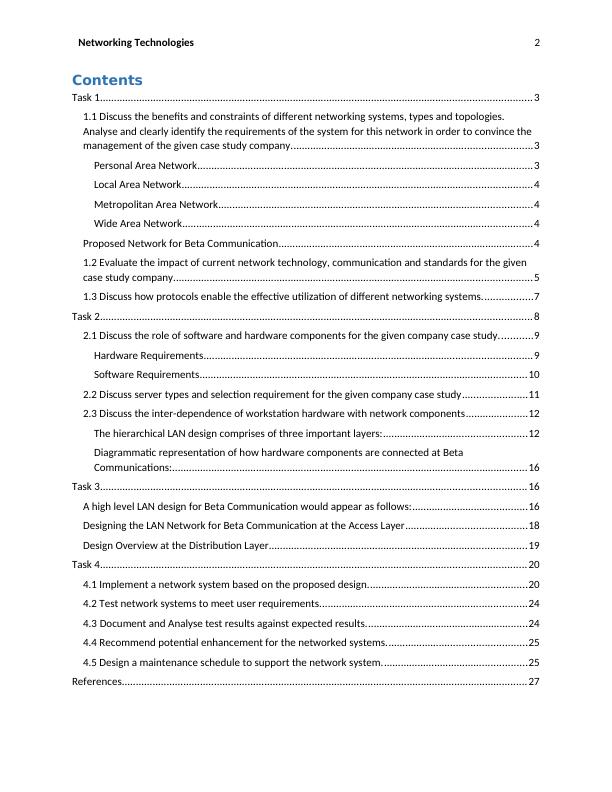
Networking Technologies 3
Task 1
1.1 Discuss the benefits and constraints of different
networking systems, types and topologies. Analyse and
clearly identify the requirements of the system for this
network in order to convince the management of the given
case study company.
Computer networks can be categorized into different types. All networks are characterized based
on the type of activities carried out by a company. The actual size of a network depends on its
geographic area, the total number of computers and people who are a part of the organization’s
network. Networks can include anything like a room with a handful of computers or a million
devices spread across the world. Networks are differentiated based on its size.
Different Types of Networking Systems
Peer to Peer network is the simplest form of network. This is where two or more computers are
connected together. These computers share resources without the help of a server. The P2P
networks can have ad hoc connections, where computers transfer files through an Universal
Serial Bus. P2P networks can be both simple or complex. In the grander scale, they need special
protocols and customized applications for the communication.
Benefits of P2P
1) These networks don’t need a network operating system
2) These networks don’t need expensive servers
3) These networks are easy to setup and they don’t need specialist staff
Drawbacks of P2P
1) It is difficult to take centralized backups
2) It is not possible to organize the network centrally
Task 1
1.1 Discuss the benefits and constraints of different
networking systems, types and topologies. Analyse and
clearly identify the requirements of the system for this
network in order to convince the management of the given
case study company.
Computer networks can be categorized into different types. All networks are characterized based
on the type of activities carried out by a company. The actual size of a network depends on its
geographic area, the total number of computers and people who are a part of the organization’s
network. Networks can include anything like a room with a handful of computers or a million
devices spread across the world. Networks are differentiated based on its size.
Different Types of Networking Systems
Peer to Peer network is the simplest form of network. This is where two or more computers are
connected together. These computers share resources without the help of a server. The P2P
networks can have ad hoc connections, where computers transfer files through an Universal
Serial Bus. P2P networks can be both simple or complex. In the grander scale, they need special
protocols and customized applications for the communication.
Benefits of P2P
1) These networks don’t need a network operating system
2) These networks don’t need expensive servers
3) These networks are easy to setup and they don’t need specialist staff
Drawbacks of P2P
1) It is difficult to take centralized backups
2) It is not possible to organize the network centrally

Networking Technologies 4
3) Performance issues are common
4) There are less secure
Client-Server Networks allow files to be stored in a specialized machine called the server. Data
is never stored in the hard disk of each workstation. The servers are designed to provide data to
remote clients whenever required. Indeed, Beta Communications requires a similar kind of
network. Where several clients are able to communicate, transfer files and store data centrally in
servers.
Benefits of Client-Server Networks
1) Files are stored centrally
2) Network devices can be controlled centrally
3) Backups and network security is never a problem
Drawbacks of Client-Server Networks
1) A specialized network operating system is required
2) Network peripherals can be very expensive
3) A trained network team is required
4) Network failures can be expensive and difficult to troubleshoot
Cloud Networking is a new and an upcoming concept where clients are allowed to access and
connect with devices that are located across the globe. Cloud gives clients the freedom to pay-as-
they-use. This form of networking helps all business technologies.
Benefits of cloud networking
3) Performance issues are common
4) There are less secure
Client-Server Networks allow files to be stored in a specialized machine called the server. Data
is never stored in the hard disk of each workstation. The servers are designed to provide data to
remote clients whenever required. Indeed, Beta Communications requires a similar kind of
network. Where several clients are able to communicate, transfer files and store data centrally in
servers.
Benefits of Client-Server Networks
1) Files are stored centrally
2) Network devices can be controlled centrally
3) Backups and network security is never a problem
Drawbacks of Client-Server Networks
1) A specialized network operating system is required
2) Network peripherals can be very expensive
3) A trained network team is required
4) Network failures can be expensive and difficult to troubleshoot
Cloud Networking is a new and an upcoming concept where clients are allowed to access and
connect with devices that are located across the globe. Cloud gives clients the freedom to pay-as-
they-use. This form of networking helps all business technologies.
Benefits of cloud networking
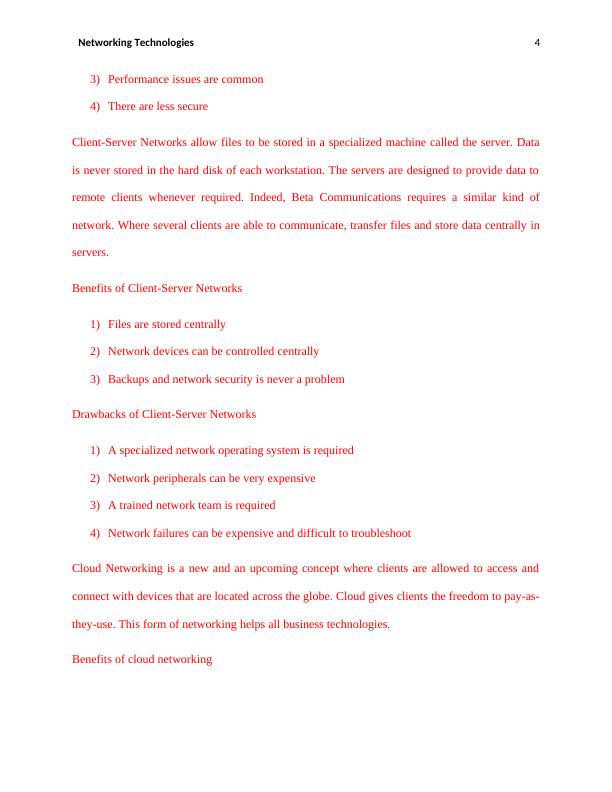
Networking Technologies 5
1) Cloud networks can save lots of money. They can follow zero in-house hardware
investments.
2) Cloud networks are reliable and much more consistent
3) Cloud networks offer an strategic edge to various companies
Drawbacks of cloud networking
1) With more clients, cloud service providers are likely to face greater downtimes
2) Security is always an issue with cloud computing
3) Clients or network managers have limited control over cloud networks
Virtualized networks help in cutting down the cost of network devices. These networks are
known for its agility and efficiency. Virtual networks are useful when there is plenty of CPU
intense processing and very little dependence on dedicated hardware. Web application firewalls
are ideal forms of virtualized networks.
Benefits of Virtual Networks
1) Resources can be shared easily
2) Network efficiency can be maintained
3) Virtual networks are easy to define
4) It is easy to extend virtual networks using Ethernet mode LANs. In the longer run, Beta
Communications can shift to virtualized networks
Drawbacks of Virtual Networks
1) Designing and constructing virtual networks is difficult
2) Security implementations are difficult
1) Cloud networks can save lots of money. They can follow zero in-house hardware
investments.
2) Cloud networks are reliable and much more consistent
3) Cloud networks offer an strategic edge to various companies
Drawbacks of cloud networking
1) With more clients, cloud service providers are likely to face greater downtimes
2) Security is always an issue with cloud computing
3) Clients or network managers have limited control over cloud networks
Virtualized networks help in cutting down the cost of network devices. These networks are
known for its agility and efficiency. Virtual networks are useful when there is plenty of CPU
intense processing and very little dependence on dedicated hardware. Web application firewalls
are ideal forms of virtualized networks.
Benefits of Virtual Networks
1) Resources can be shared easily
2) Network efficiency can be maintained
3) Virtual networks are easy to define
4) It is easy to extend virtual networks using Ethernet mode LANs. In the longer run, Beta
Communications can shift to virtualized networks
Drawbacks of Virtual Networks
1) Designing and constructing virtual networks is difficult
2) Security implementations are difficult

Networking Technologies 6
Clustered networks are a superset of centralized network systems. Even client-server networks
are a form of centralized networks. Here, a group of machines are connected together with a
centralized server. The server helps with storing files and handling communication. It is possible
to include as many clients as required in a clustered/centralized networking system.
Different types of network are:
1) Personal area network (PAN)
2) Local area network (LAN)
3) Metropolitan area network (MAN)
4) Wide area network (WAN)
There are few network types for general purpose too. This includes the process of sending
files from one system to another or the internet. This includes the following:
1) Storage area network (SAN)
2) Enterprise Private Network (EPN)
3) Virtual Private Network (VPN)
Personal Area Network
Personal area network is an organized network around a particular individual. The individual is
bound within a single building. The building could be anything like his residence or office. An
ideal PAN is built using one or more peripheral devices, telephone and computers. If several
people are using the network, it is also known as home area network (HAN).
Local Area Network
Local Area Network comprises of computers in a specific site. Often, individual office building
invest on LAN. The LAN is extremely helpful in sharing printers, data storage and other
resources. LANs can be established very easily, using hardware devices like Ethernet cables,
Clustered networks are a superset of centralized network systems. Even client-server networks
are a form of centralized networks. Here, a group of machines are connected together with a
centralized server. The server helps with storing files and handling communication. It is possible
to include as many clients as required in a clustered/centralized networking system.
Different types of network are:
1) Personal area network (PAN)
2) Local area network (LAN)
3) Metropolitan area network (MAN)
4) Wide area network (WAN)
There are few network types for general purpose too. This includes the process of sending
files from one system to another or the internet. This includes the following:
1) Storage area network (SAN)
2) Enterprise Private Network (EPN)
3) Virtual Private Network (VPN)
Personal Area Network
Personal area network is an organized network around a particular individual. The individual is
bound within a single building. The building could be anything like his residence or office. An
ideal PAN is built using one or more peripheral devices, telephone and computers. If several
people are using the network, it is also known as home area network (HAN).
Local Area Network
Local Area Network comprises of computers in a specific site. Often, individual office building
invest on LAN. The LAN is extremely helpful in sharing printers, data storage and other
resources. LANs can be established very easily, using hardware devices like Ethernet cables,
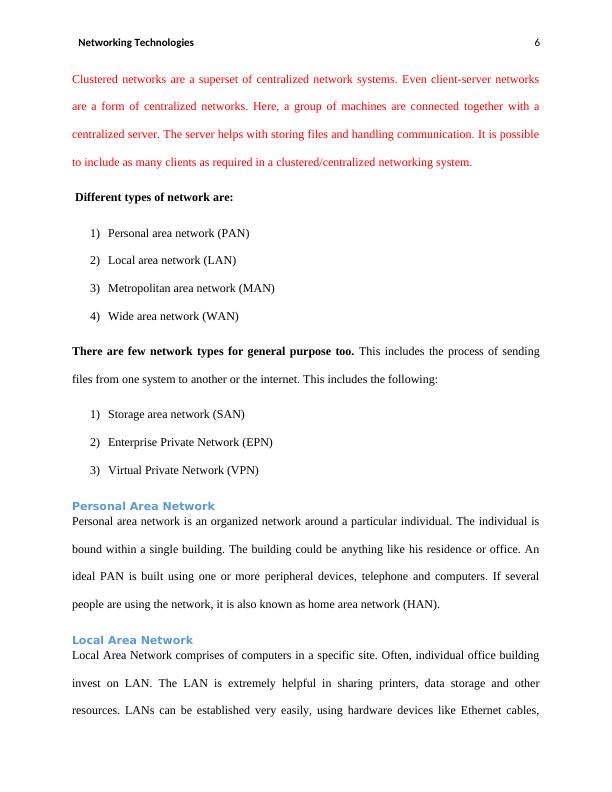
Networking Technologies 7
network adapters and hubs. A very small LAN comprises of 2 machines, whereas there can be
huge LAN structures that connect numerous computers. LAN relies on wired connections that
ensure high security and speed. LANs are best used in single site applications where people need
to share resources among a known group and not the entire world.
Metropolitan Area Network
MAN connects computers within a city, campus or a region bigger than what a LAN can cover.
MAN depends on network configuration. It can be used to connect areas that range from several
miles to tens of miles.
Wide Area Network
Wide Area Network is used to connect an entire nation or the whole world. WAN comprises of
several smaller network. WAN can be a collection of MANs and LANs. The internet is a very
good example of a public WAN.
Proposed Network for Beta Communication
Beta communication wants a network that can connect three buildings. These buildings have
employees and devices to handle the company’s day to day operations. According to present
requirements, the company doesn’t want a network that connects the entire region, country or
world. The best network type to satisfy this requirement would be “LAN”. With an efficient
LAN connection, Beta communication will be able to communicate, share and manage devices,
people and data that is spread across three buildings. The company can expand this LAN
connection to more buildings when required. Moreover, LAN allows easy access, high security
and fast data transfer rates. It is easy to separate responsibilities across each building with the
help of LAN.
Different network topologies
network adapters and hubs. A very small LAN comprises of 2 machines, whereas there can be
huge LAN structures that connect numerous computers. LAN relies on wired connections that
ensure high security and speed. LANs are best used in single site applications where people need
to share resources among a known group and not the entire world.
Metropolitan Area Network
MAN connects computers within a city, campus or a region bigger than what a LAN can cover.
MAN depends on network configuration. It can be used to connect areas that range from several
miles to tens of miles.
Wide Area Network
Wide Area Network is used to connect an entire nation or the whole world. WAN comprises of
several smaller network. WAN can be a collection of MANs and LANs. The internet is a very
good example of a public WAN.
Proposed Network for Beta Communication
Beta communication wants a network that can connect three buildings. These buildings have
employees and devices to handle the company’s day to day operations. According to present
requirements, the company doesn’t want a network that connects the entire region, country or
world. The best network type to satisfy this requirement would be “LAN”. With an efficient
LAN connection, Beta communication will be able to communicate, share and manage devices,
people and data that is spread across three buildings. The company can expand this LAN
connection to more buildings when required. Moreover, LAN allows easy access, high security
and fast data transfer rates. It is easy to separate responsibilities across each building with the
help of LAN.
Different network topologies
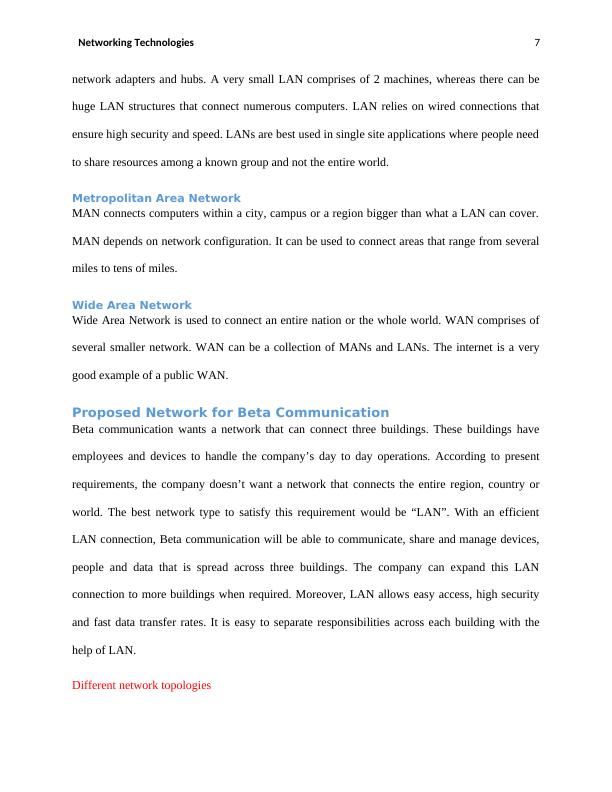
Networking Technologies 8
Network topology defines the way nodes or devices in a network are connected. It also defines
how networks communicate with one another. Each arrangement has its own advantages and
disadvantages.
The Bus topology has a central bus to which all network nodes are connected. All computers and
devices are connected to a single cable. This topology has two end points and nothing more. This
is an example of a linear topology. Data is transmitted in a single direction.
Benefits of Bus topology:
1) cost effective
2) fewer cables are required
3) easy to expand in a linear fashion
Drawbacks of Bus topology
1) cable failures can bring down the entire network
2) heavy network traffic will decrease the network’s performance
Recommendation
It is not recommended for businesses to rely on bus topology. That is because the length of
cables is greatly limited and the risks of network failures are high.
Ring Topology is where all computers are connected to form a ring. The last device is connected
to the first device. Every device will have exactly two neighbors. This topology has plenty of
repeaters. If nodes want to communicate with one another, data would be transmitted to all the
nodes in between. Data is often transmitted in a sequential fashion, and two way communication
is possible in dual ring topologies.
Network topology defines the way nodes or devices in a network are connected. It also defines
how networks communicate with one another. Each arrangement has its own advantages and
disadvantages.
The Bus topology has a central bus to which all network nodes are connected. All computers and
devices are connected to a single cable. This topology has two end points and nothing more. This
is an example of a linear topology. Data is transmitted in a single direction.
Benefits of Bus topology:
1) cost effective
2) fewer cables are required
3) easy to expand in a linear fashion
Drawbacks of Bus topology
1) cable failures can bring down the entire network
2) heavy network traffic will decrease the network’s performance
Recommendation
It is not recommended for businesses to rely on bus topology. That is because the length of
cables is greatly limited and the risks of network failures are high.
Ring Topology is where all computers are connected to form a ring. The last device is connected
to the first device. Every device will have exactly two neighbors. This topology has plenty of
repeaters. If nodes want to communicate with one another, data would be transmitted to all the
nodes in between. Data is often transmitted in a sequential fashion, and two way communication
is possible in dual ring topologies.
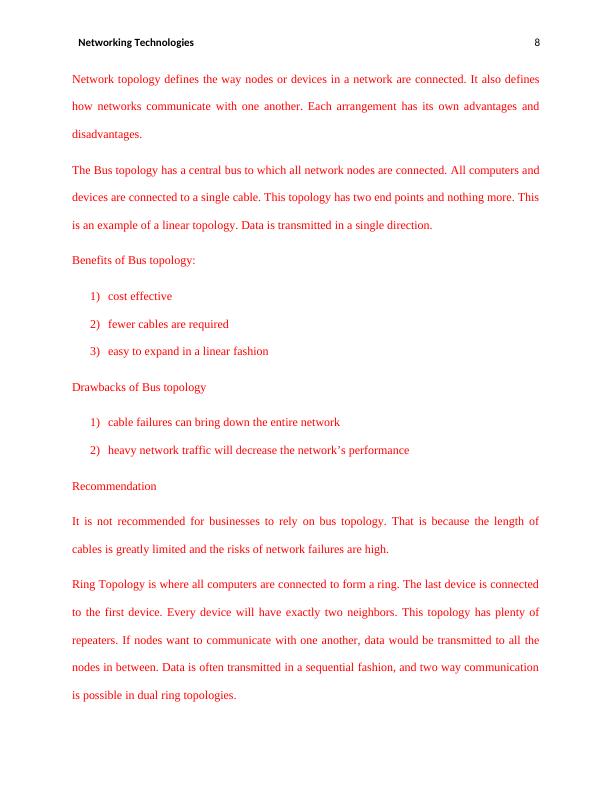
End of preview
Want to access all the pages? Upload your documents or become a member.
Related Documents
Network Technology, Communication and Standard : Case Studylg...
|41
|8806
|131
Impact of Network Technology, Communication and Standardslg...
|32
|7082
|103
Networking Technologies: Types, Topologies, and Impactlg...
|19
|3875
|466
Network Principles and Protocolslg...
|13
|3704
|69
LAN Architecture for Top Network Companylg...
|11
|657
|77
Assignment on Network Information Systemslg...
|11
|2752
|12
